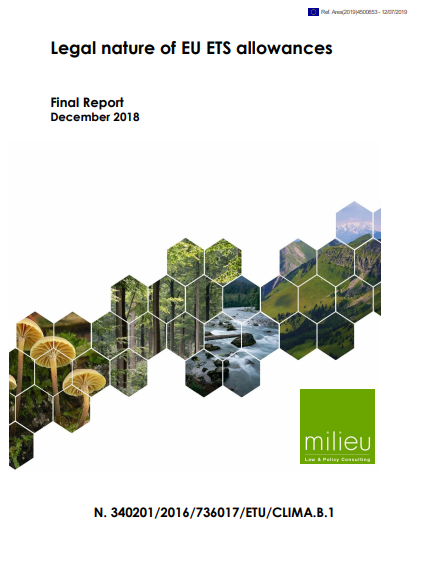© Oliver Boehmer | bluedesign®
Legal Nature of EU ETS Allowances
- Project
- Duration
-
-
The EU Emissions Trading System (EU ETS) has been in operation since 2005, and is considered as the flagship instrument in the EU's efforts to combat climate change. Interestingly, though, the EU ETS Directive does not specify the legal nature of the allowances traded within the EU Emission Trading System. Allowances can be considered as a property, as an administrative right or permit, or as a financial instrument, and all interpretations can be found in different EU legislation. Effectively, the EU left it to the discretion of the Member States to defined the legal nature of the allowances through their national legislation. In practice, the definitions used by Member States vary considerably as a result of this discretion.
The objective of this project is to provide clarity on the legal nature of the allowances traded in the the EU Emission Trading System. This exludes international carbon units (e.g. assigned amount units (AAUs), certified emission reductions (CERs), emission reduction units (ERUs)) pursuant to the Kyoto Protocol to the UN Framework Convention on Climate Change.
To this end, the project had the following aims:
- Outline the characteristics of allowances which are typical of private property rights, administrative rights or sui generis rights, based on current EU legislation, national Member State regimes, and case law.
- Provide a detailed legal analysis of the treatment of allowances in five selected Member States: Belgium, Germany, France, Poland and the UK. This analysis is based on Article 21 reports, literature desk research and interviews with relevant authorities and stakeholders.
- Identify the main issues relating to the legal nature of allowances which may have practical implications on the legal certainty, investment confidence and liquidity of the carbon market.
- Consider the following aspects of the legal nature of allowances in order to determine their impact on the legal nature of the ETS allowances: property rights, establishing security interest, insolvency, taxation, accounting, and criminal justice.
- Identify the consequences of recognising the allowances as financial instruments under MiFID II, with respect to the legal nature of the allowances.
- Present options for further clarification of the legal nature of allowances in view of the abovementioned issues, and propose solutions, including changes to the relevant legal framework or soft law measures. The options and tools should be analysed for their feasibility, benefit and effort required.
The study is also intended to address the 2015 report of the European Court of Auditors on the integrity and the implementation of the EU ETS, which highlighted the need for a clearly defined and harmonised definition of the legal nature of the allowances, as the current lack of definition at EU level might affect the legal certainty and liquidity of the market.
The final report of the project analysed the existing legislation and practice during phase III of the EU ETS (2013-2020). As for the legislation on the financial markets related to the EU ETS, the basic assumptions are grounded in Directive 2014/65/EU on markets in financial instruments (MiFID II), which applies as of January 2018, since which date allowances are classified as financial instruments. The report provides an analysis of the EU legislation which needs to be considered for the EU ETS and the legal nature of allowances. It also presents an analytical overview of property and administrative characteristics of the allowances.
The analysis at EU level is complemented by a legal analysis of selected Member States (United Kingdom, Germany, France, Poland and Belgium), followed by an analysis of key issues related to the legal nature of allowances, specifically legal certainty, liquidity of the market and criminal issues, including those deriving from the abuse of VAT legislation, accounting and security interests. Finally, the report analyses the consequences of recognising allowances as financial instruments.
The Ecologic Institute contributed various aspects of the analysis – including an analysis how the legal nature of EU allowance may impact market liquidity and the risk of criminal issues, as well as an analysis of the legal nature of EU allowances in German law.




